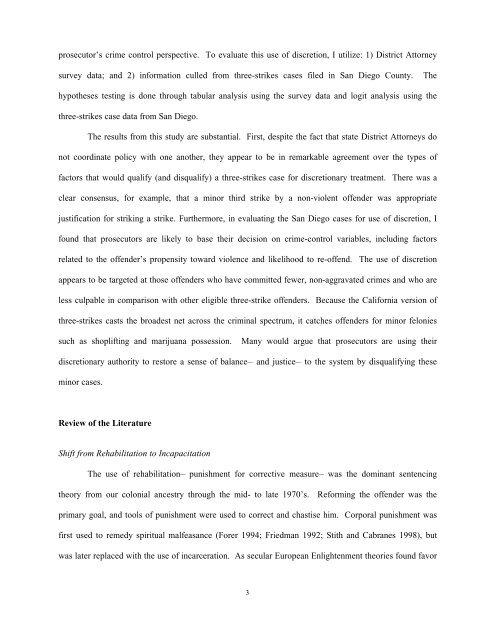“In the Furtherance of Justice”: The Effect of Discretion on the ...
“In the Furtherance of Justice”: The Effect of Discretion on the ...
“In the Furtherance of Justice”: The Effect of Discretion on the ...
You also want an ePaper? Increase the reach of your titles
YUMPU automatically turns print PDFs into web optimized ePapers that Google loves.
prosecutor’s crime c<strong>on</strong>trol perspective. To evaluate this use <str<strong>on</strong>g>of</str<strong>on</strong>g> discreti<strong>on</strong>, I utilize: 1) District Attorney<br />
survey data; and 2) informati<strong>on</strong> culled from three-strikes cases filed in San Diego County. <str<strong>on</strong>g>The</str<strong>on</strong>g><br />
hypo<str<strong>on</strong>g>the</str<strong>on</strong>g>ses testing is d<strong>on</strong>e through tabular analysis using <str<strong>on</strong>g>the</str<strong>on</strong>g> survey data and logit analysis using <str<strong>on</strong>g>the</str<strong>on</strong>g><br />
three-strikes case data from San Diego.<br />
<str<strong>on</strong>g>The</str<strong>on</strong>g> results from this study are substantial. First, despite <str<strong>on</strong>g>the</str<strong>on</strong>g> fact that state District Attorneys do<br />
not coordinate policy with <strong>on</strong>e ano<str<strong>on</strong>g>the</str<strong>on</strong>g>r, <str<strong>on</strong>g>the</str<strong>on</strong>g>y appear to be in remarkable agreement over <str<strong>on</strong>g>the</str<strong>on</strong>g> types <str<strong>on</strong>g>of</str<strong>on</strong>g><br />
factors that would qualify (and disqualify) a three-strikes case for discreti<strong>on</strong>ary treatment. <str<strong>on</strong>g>The</str<strong>on</strong>g>re was a<br />
clear c<strong>on</strong>sensus, for example, that a minor third strike by a n<strong>on</strong>-violent <str<strong>on</strong>g>of</str<strong>on</strong>g>fender was appropriate<br />
justificati<strong>on</strong> for striking a strike. Fur<str<strong>on</strong>g>the</str<strong>on</strong>g>rmore, in evaluating <str<strong>on</strong>g>the</str<strong>on</strong>g> San Diego cases for use <str<strong>on</strong>g>of</str<strong>on</strong>g> discreti<strong>on</strong>, I<br />
found that prosecutors are likely to base <str<strong>on</strong>g>the</str<strong>on</strong>g>ir decisi<strong>on</strong> <strong>on</strong> crime-c<strong>on</strong>trol variables, including factors<br />
related to <str<strong>on</strong>g>the</str<strong>on</strong>g> <str<strong>on</strong>g>of</str<strong>on</strong>g>fender’s propensity toward violence and likelihood to re-<str<strong>on</strong>g>of</str<strong>on</strong>g>fend. <str<strong>on</strong>g>The</str<strong>on</strong>g> use <str<strong>on</strong>g>of</str<strong>on</strong>g> discreti<strong>on</strong><br />
appears to be targeted at those <str<strong>on</strong>g>of</str<strong>on</strong>g>fenders who have committed fewer, n<strong>on</strong>-aggravated crimes and who are<br />
less culpable in comparis<strong>on</strong> with o<str<strong>on</strong>g>the</str<strong>on</strong>g>r eligible three-strike <str<strong>on</strong>g>of</str<strong>on</strong>g>fenders. Because <str<strong>on</strong>g>the</str<strong>on</strong>g> California versi<strong>on</strong> <str<strong>on</strong>g>of</str<strong>on</strong>g><br />
three-strikes casts <str<strong>on</strong>g>the</str<strong>on</strong>g> broadest net across <str<strong>on</strong>g>the</str<strong>on</strong>g> criminal spectrum, it catches <str<strong>on</strong>g>of</str<strong>on</strong>g>fenders for minor fel<strong>on</strong>ies<br />
such as shoplifting and marijuana possessi<strong>on</strong>. Many would argue that prosecutors are using <str<strong>on</strong>g>the</str<strong>on</strong>g>ir<br />
discreti<strong>on</strong>ary authority to restore a sense <str<strong>on</strong>g>of</str<strong>on</strong>g> balance— and justice— to <str<strong>on</strong>g>the</str<strong>on</strong>g> system by disqualifying <str<strong>on</strong>g>the</str<strong>on</strong>g>se<br />
minor cases.<br />
Review <str<strong>on</strong>g>of</str<strong>on</strong>g> <str<strong>on</strong>g>the</str<strong>on</strong>g> Literature<br />
Shift from Rehabilitati<strong>on</strong> to Incapacitati<strong>on</strong><br />
<str<strong>on</strong>g>The</str<strong>on</strong>g> use <str<strong>on</strong>g>of</str<strong>on</strong>g> rehabilitati<strong>on</strong>— punishment for corrective measure— was <str<strong>on</strong>g>the</str<strong>on</strong>g> dominant sentencing<br />
<str<strong>on</strong>g>the</str<strong>on</strong>g>ory from our col<strong>on</strong>ial ancestry through <str<strong>on</strong>g>the</str<strong>on</strong>g> mid- to late 1970’s. Reforming <str<strong>on</strong>g>the</str<strong>on</strong>g> <str<strong>on</strong>g>of</str<strong>on</strong>g>fender was <str<strong>on</strong>g>the</str<strong>on</strong>g><br />
primary goal, and tools <str<strong>on</strong>g>of</str<strong>on</strong>g> punishment were used to correct and chastise him. Corporal punishment was<br />
first used to remedy spiritual malfeasance (Forer 1994; Friedman 1992; Stith and Cabranes 1998), but<br />
was later replaced with <str<strong>on</strong>g>the</str<strong>on</strong>g> use <str<strong>on</strong>g>of</str<strong>on</strong>g> incarcerati<strong>on</strong>. As secular European Enlightenment <str<strong>on</strong>g>the</str<strong>on</strong>g>ories found favor<br />
3


